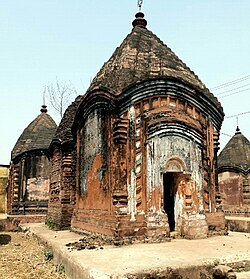Maluti
| Maluti | |
|---|---|
| Village | |
 |
|
| Country | India |
| State | Jharkhand |
| District | Dumka district |
| Time zone | Indian Standard Time (UTC+5.30) |
Maluti (also Malooti, or মলূঢি) is a small village near Shikaripara in Dumka District of Jharkhand, India. The place has 72 old temples. It was built under the Baj Basanta dynasty. The 72 temples are edifices to the kings of the Pala Dynasty. They portray various scenes from Hindu mythology including the Ramayana and the Mahabharata. Maluti is known for the annual sacrifice of over 100 goats on Kali Puja, besides one buffalo and a sheep, though animal activist groups have often strongly looked down at this activity. Today Maluti is endangered by insufficient management of the old temples, and threatened by natural disasters.
Maluti village came into limelight in fifteenth century as the capital of nankar raj (tax-free kingdom). The kingdom was awarded to one Basanta Roy of village Katigram by Sultan Alauddin Hussan Shah of Gaura (1495–1525). Son of a poor Brahmin Basanta managed to catch the pet hawk of the sultan and gave it back to the sultan. In lieu of the hawk (Baj), Basanta was given the kingdom. Hence, the king was called Raja Baj Basanta. The capital of Baj Basanta dynasty was in Damra. Later it was shifted to Maluti. The royal family was very pious.
Basanta became a king in lieu of a baj (hawk) by the help of a Dandi Sanyasi of Sumeru Math, Kashi may be true to a great extent because the word Baj has been pre-fixed with the name if Basanta to commemorate the event. The name Baj Basanta is comparatively prominent because it can be found both in local history and government records. Swamiji, the head of Sumeru Math, Varanasi, was the preceptor of Basanta. Since then the head of Sumeru Math who is called Rajguru becomes the preceptor of descendants of king Baj Banata. Even today Rajguru from Sumeru Math Varanasi spends sometime at Maluti every year.
How Maluti — the capital of Baj Basanta dynasty — turn out to be a 'temple city' is also an interesting story. Instead of constructing palaces, the Rajas built temples. The dynasty was broken into parts (tarafs) but each taraf kept building temples, competing with the others. In the end, it turned out be a unique temple village. Inscriptions in Proto-Bengali on the temples show they were named after women.
In another opinion the name of the village Maluti probably comes from Mallahati of Malla Kings of Bankura, vishnupur had suzerainty over this area. That point of time this area ruled by Malla kings of Bankura was Damin-i-koh ( present pakur in north. Burdwan in the east, Midnapore in south and some portion of Chota Nagpur Plateau in west) This vast land was called Mallabhum. The village might have been named in those days by prefixing 'Malla' in relevance with royal dynasty.
...
Wikipedia
